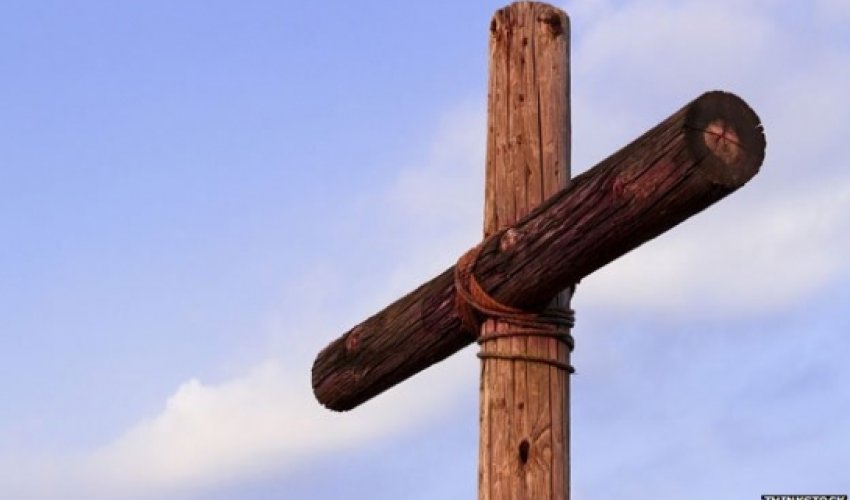Crucifixion from ancient Rome to modern Syria

The dead men in the photographs are blindfolded - their limp, outstretched arms tied to planks of wood with green string.A banner wrapped around one of the bloodied corpses reads: "This man fought against Muslims and set off an explosive device here."The photos show a handful of people, including children, taking a closer look while others go about their normal business in the northern city of Raqqa, unfazed by the bodies suspended a few feet away.The bodies remained on display in the centre of a roundabout for two days according to the UK-based Syrian Observatory for Human Rights. A jihadist group, the Islamic State in Iraq and the Levant (ISIS), is thought to have been responsible.As with a similar case in Raqqa in March, the men are thought to have been executed first, before being attached to crosses and publicly displayed.Amnesty International also documented a case of crucifixion in Yemen in 2012, when an Islamist group found a 28-year-old guilty of planting electronic devices in vehicles, enabling US drones to track and kill their occupants. He too was executed first and hung on a cross afterwards.Sheikh Dr Usama Hasan, Islamic scholar and senior researcher in Islamic Studies at the Quilliam Foundation in London, says this form of punishment arises from a very literal, or fundamentalist, reading of the Koran.Verse 33 of the fifth book of the Koran says: "Indeed, the penalty for those who wage war against Allah and His Messenger and strive upon earth [to cause] corruption is none but that they be killed or crucified or that their hands and feet be cut off from opposite sides or that they be exiled from the land. That is for them a disgrace in this world; and for them in the Hereafter is a great punishment."But Hasan says this passage should not be read in isolation. He cites the following verse which reads: "Except for those who return [repenting] before you apprehend them. And know that Allah is Forgiving and Merciful."Verses of the Koran which sound very harsh are always followed by the option of repentance and a "reminder that God is ultimately forgiving and merciful," he says."These groups tend to be very harsh and unmerciful which is why it is our contention that they are extremely un-Islamic and very far from the spirit of Islam."For Hasan, crucifixion has no place in the modern world. What happened in Raqqa was intended as a warning to anyone questioning the authority of Isis, he suggests.Although crucifixion is mentioned in the Koran, it plays a bigger role in the Bible. While Islam recognises Jesus as a prophet, it does not believe, as Christianity does, that he was crucified.Crucifixion had become an established form of execution in the Roman Empire long before Jesus's birth."The famous example is Spartacus," says Prof Mary Beard, referring to the Roman slave and gladiator who died in 71BC, after leading a slave revolt."When Crassus finishes off the slave rebellion he lines the Appian Way with crucifixions," she says. It's estimated that 6,000 of Spartacus's followers were killed in this way."In Republican Rome, 1st Century BC Rome, it is a standard and degrading form of punishment," says Beard, a classical historian at Cambridge University."If you are a Roman citizen you do not get crucified. St Peter gets crucified in Rome - in the martyrdom of Peter and Paul the difference is that Paul is a Roman citizen and Peter isn't."It is thought that Paul was beheaded - a quicker and therefore preferable death.Although there are references to crucifixions hundreds of years before the Romans these may refer to other forms of impalement - cases where offenders were nailed to trees and other frames, where they were left to die.The Latin word "crux" which is generally translated as "cross" originally had a less specific meaning, referring to any object on which victims were impaled or hanged.The Roman emperor Constantine, a Christian, banned crucifixion in the 4th Century AD. More than 1,000 years later, however, it resurfaced as a way of killing Christians in Japan.In 1597, 26 Christians were crucified in Nagasaki and over the following century, hundreds more were executed in the same way."The reason they go for crucifixion is that often as well as killing somebody, it's the exposure and the humiliation and also the warning to other people," says Timon Screech, professor of Japanese history at the School of Oriental and African Studies in London."There are descriptions where the executioner leaves them up for a couple of hours, or it might be until dusk, and then kills them with a sword," he says.The punishment began to be used against non-Christians too. In 1651, about 150 people were crucified after the Keian Disturbance, a failed uprising against the Shogun."I suspect that by the end of the 17th Century in Japan, its association with Christianity has been rather forgotten by most people," says Screech.But the authorities eventually concluded such a public form of execution drew too much attention to serious crimes against the state that it would be better to hush up. "Punishments go back to secret assassinations in a dark place," says Screech.There were also cases where Japanese soldiers crucified people in World War Two. The best documented is that of three Australian prisoners of war working on the Thailand-Burma railway, who were sentenced to death for killing cattle. Bound to a tree, only one of them survived - Herbert James "Ringer" Edwards, who became the inspiration for the character Joe Harman in Nevil Shute's novel, A Town Like Alice.Today, a punishment referred to as "crucifixion" can still be imposed by courts in Saudi Arabia."Crucifixions take place after the beheading," says Amnesty International, which campaigns against all forms of capital punishment."The body, with the separated head sewn back on, is hung from or against a pole in public to act as a deterrent."The pole is sometimes, but not always, shaped in the form of a cross.(BBC)Bakudaily.az




































 Photo
Photo 



 Video
Video 

